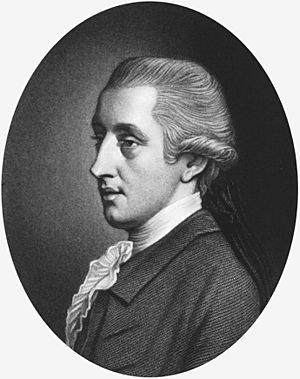William Hewson (surgeon) facts for kids
Quick facts for kids
William Hewson
|
|
|---|---|
 |
|
| Born | 14 November 1739 |
| Died | 1 May 1774 (aged 34) |
| Known for | haematology |
| Awards | Copley Medal (1769) |
| Scientific career | |
| Fields | Surgery anatomist physiologist |
William Hewson (born November 14, 1739 – died May 1, 1774) was a British scientist. He was a surgeon, an anatomist (someone who studies the body's structure), and a physiologist (someone who studies how the body works). He is often called the "father of haematology," which is the study of blood.
Contents
Early Life and Education
William Hewson was born in Hexham, a town in Northumberland, England. He began his medical studies in 1753 at the Newcastle Infirmary. This hospital is now known as the Royal Victoria Infirmary. He learned from its founder, Richard Lambert.
Later, in 1761 and 1762, Hewson studied in Edinburgh. He became a student and then an assistant to William Hunter, another famous anatomist.
Amazing Discoveries in Science
Hewson made many important discoveries in medicine. In 1768, he became a member of the American Philosophical Society. He won the important Copley Medal in 1769 for his work. In 1770, he was chosen to join the Royal Society, a group of top scientists.
Understanding Blood
One of his biggest contributions was finding and separating something called fibrin. Fibrin is a very important protein in your blood. It helps your blood clot when you get a cut. This stops you from bleeding too much.
The Lymphatic System
Hewson also showed that animals have special tubes called lymph vessels. He explained what these vessels do. He believed that humans also have a similar system, which we now call the lymphatic system. This system helps fight infections and keeps your body healthy.
Red Blood Cells and Cell Membranes
He also studied red blood cells. Before Hewson, people thought these cells were round like tiny balls. But Hewson proved that they are actually shaped like tiny flat discs. He even suggested that red blood cells have a kind of outer layer, which we now call a cell membrane. This idea was very advanced for his time!
Personal Life and Anatomy School
On July 10, 1770, William Hewson married Mary Stevenson. She was a friend of the famous American inventor and statesman, Benjamin Franklin.
In September 1772, Hewson started his own anatomy school. It was located at 36 Craven Street in London. Interestingly, Benjamin Franklin also lived in this house for a time. Today, this building is a museum called the Benjamin Franklin House.
Studying the Human Body
When the London home was being fixed up in 1998, workers found some old bones hidden underneath. These bones likely belonged to people and animals that Hewson used for his studies. He was an anatomist, which means he studied the structure of bodies to understand how they work. This was a common practice for scientists at that time to learn about human and animal anatomy.
Evidence found with the bones showed that Hewson was doing experiments. For example, they found mercury with turtle bones and a red coloring with dog bones. Hewson had written about using these things in his studies of the lymphatic system.
His Legacy
Sadly, William Hewson died young on May 1, 1774. He got a serious infection while working with a cadaver (a body used for study).
After his death, Hewson's work was continued by Magnus Falconar. Falconar had married Hewson's sister. He repeated Hewson's experiments and helped publish Hewson's important findings about red blood cells in 1777. This made sure Hewson's discoveries were shared with the world.

